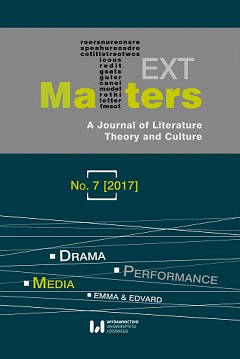Sensing the Present: “Conceptual Art of the Senses”
DOI:
https://doi.org/10.1515/texmat-2017-0002Keywords:
senses, abstraction, writing, affect, aestheticAbstract
After Rachel E. Burke briefly introduces the essays presented with a focus on our contemporary relationship to modern subjectivity, Mieke Bal will make the case for the sense of presentness on an affective and sensuous level in Munch’s paintings and Flaubert’s writing by selecting a few topics and cases from the book Emma and Edvard Looking Sideways: Loneliness and the Cinematic, published by the Munch Museum in conjunction with the exhibition Emma & Edvard. It is this foregrounded presentness that not only produces the ongoing thematic relevance of these works, but more importantly, the sense-based conceptualism that declares art and life tightly bound together. If neither artist eliminated figuration in favour of abstraction, they had a good reason for that. Art is not a representation of life, but belongs to it, illuminates it and helps us cope with it by sharpening our senses. As an example, a few paintings will clarify what I mean by the noun-qualifier “cinematic” and how that aesthetic explains the production of loneliness.
Downloads
References
Bal, Mieke. Emma and Edvard Looking Sideways: Loneliness and the Cinematic. Oslo: Munch Museum; Brussels: Mercatorfonds; Yale UP, 2017. Print.
Google Scholar
Bal, Mieke. Travelling Concepts in the Humanities: A Rough Guide. Toronto: The U of Toronto P, 2001. Print.
Google Scholar
Berman, Patricia G. “Scratching the Surface: On and In Self Portrait (1895).” Kunst og Kultur 1–2 (2017): 75–95. Print.
Google Scholar
Culler, Jonathan. Flaubert: The Uses of Uncertainty. Aurora, CO: Davies Group, 1974. Print.
Google Scholar
Culler, Jonathan. “The Performative.” The Literary in Theory. Stanford, CA: Stanford UP, 2007. 137–65. Print.
Google Scholar
Eisenstein, Sergei. “Through Theatre to Cinema.” Film Form. Ed. and trans. Jay Leyda. New York: Harcourt, 1998. 3–17. Print.
Google Scholar
Flaatten, Hans-Martin Frydenberg. “Edvard Munch’s ‘Studies for a Picture Series’: The Frieze of Life and its Background in the Prose Poetry and Literary Symbolism of the 1890s.” eMunch.no: Text and Image. Ed. Mai Britt Guleng and Karen E. Lerheim. Oslo: Munch Museum, 2012. 133–41. Print.
Google Scholar
Flaubert, Gustave. Madame Bovary. Paris: Club de l’Honnête Homme, 1971. Print.
Google Scholar
Flaubert, Gustave. Madame Bovary. Trans. Paul de Man (based on the version by Eleanor Marx Aveling, 1886). New York: Norton, 1965. Print.
Google Scholar
Itten, Johannes. The Elements of Color: A Treatise of the Color System of Johannes Itten, Based on His Book “The Art of Color.” Ed. Faber Birren. Trans. Ernst van Hagen. Chichester: Wiley, 1970. Print.
Google Scholar
LaCapra, Dominic. Madame Bovary on Trial. Ithaca, NY: Cornell UP, 1982. Print.
Google Scholar
Lowenthal, David. The Past is a Foreign Country. New York: Cambridge UP, 1985. Print.
Google Scholar
Owesen, Ingeborg. “Edvard Munch Between Gender, Love, and Women’s Rights.” Edvard Munch: 1863–1944. Ed. Mai Britt Guleng, Brigitte Sauge and Jon-Ove Steihaug. Oslo: Munch Museet; Milano: Skira Editore, 2013. 296–305. Print.
Google Scholar
Prelinger, Elizabeth. After the Scream: The Late Paintings of Edvard Munch. Atlanta, GA: High Museum of Art in association with Yale UP, 2002. Print.
Google Scholar
Schor, Naomi, and Henry F. Majewski, eds. Flaubert and Postmodernism. Lincoln, NE: U of Nebraska P, 1984. Print.
Google Scholar
Tøjner, Poul Erik. Munch in His Own Words. Munich: Prestel, 2001. Print.
Google Scholar
Downloads
Published
How to Cite
Issue
Section
License
Copyright (c) 2017 A Journal of Literature, Theory and Culture

This work is licensed under a Creative Commons Attribution-NonCommercial-NoDerivatives 4.0 International License.













